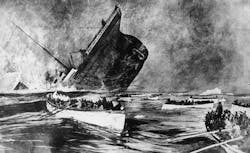Five Safety Lessons Learned from the Sinking of the Titanic
Headlines about catastrophes, accidents and fines related to safety performance grab our attention, and there often is more than enough finger-pointing to go around.
April 15th marks the 103rd year anniversary of a major maritime catastrophe: the sinking of the Titanic, arguably one of the most talked about safety tragedies of 20th century. The sinking of the “unsinkable” Titanic resulted in the deaths of more than 1,500 passengers and crew. The tragedy shocked the world, because the Titanic had been touted as “the safest ship ever built.”
There were many lessons learned from the mistakes that led to the sinking of the Titanic. One hundred years and counting after the tragedy, maybe it’s time to celebrate the safety improvements that resulted from the tragedy, and the ideas generated, shared and implemented for future use. The sinking of the Titanic, and the subsequent inquiries and investigations, should be seen as one of the factors that turned the tide in maritime safety.
Here are five lessons about Titanic that impacted the safety of future vessels:
Outdated Standards and Requirements – The Titanic only was supplied with enough life boats and life jackets for half of its maximum number of passengers. The Board of Trade had no safety regulations in place for a ship of that size. The only requirement in place was the 1894 Merchant Shipping Act, which required that the number of lifeboats be in direct proportion with the ship's gross tonnage. That rule may have sufficed, but the act only provided calculations for ships up to 10,000 tons, in which 16 life boats were required. Titanic was more than four times that size, some 46,000 tons, and carried only 20 lifeboats.
Lack of Training – The 20 lifeboats were not used to full capacity. At least four lifeboats were filled at 50 percent capacity or less. One lifeboat that could carry 40 people only had 12 passengers. The lifeboat drill that was scheduled to take place the day the Titanic hit the iceberg was cancelled by Captain Edward J. Smith. There is speculation that the training could have impacted the outcome of the emergency escape, potentially saving more lives.
Adequate Tools and Protection – The ship was short on safety equipment. Some of the officers on the bridge did not have binoculars or search lights. This fact, among many others, may have contributed to the officers only having 37 seconds to react before they hit the iceberg. Each minute gained potentially could have saved hundreds more lives.
Emergency Backup – There was another ship, the Californian, within 30 miles of the Titanic, and its crew saw flares and intercepted emergency response requests. During investigations after the Titanic sinking, a U.S. Senate subcommittee and the British Board of Trade both concluded that the Californian could have rescued some of the 700 people who were left floating in the water for three hours before the Carpathia made it to that location to rescue survivors.
Over the years, people have speculated about why the captain of the Californian decided not to respond to the distress calls. Some say he didn’t realize the seriousness of the situation or that there was a miscommunication, while others claim it was negligence. What is clear is that rather than issue the order to respond, the captain of the Californian went to bed. In response to this, vessel emergency response plans were implemented by governing agencies in the United States and the United Kingdom. These plans include, but are not limited to, required training and emergency response from nearby vessels.
Agencies Formed and Protocol Set – The first International Convention for the Safety of Life at Sea (SOLAS) convened Nov. 12, 1913 in response to the Titanic disaster. A treaty was signed by the conference in January 1914, resulting in the formation of the International Ice Patrol. The United States Coast Guard formed the agency to monitor and report on the location of North Atlantic Ocean icebergs that could pose a threat to transatlantic sea traffic.
Lessons have been learned from the 1,500 lives lost on the Titanic. From increased training and appropriate personal protection to standardizing requirements for emergency procedures, maritime safety has improved and many lives have been saved.
About the Author: Mandy Savage is a copywriter with Graphic Products.
